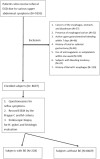Increased Prevalence of Barrett's Esophagus in Taiwan: A Prospective Multicenter Study
- PMID: 40300615
- PMCID: PMC12212406
- DOI: 10.1111/jgh.16992
Increased Prevalence of Barrett's Esophagus in Taiwan: A Prospective Multicenter Study
Abstract
Background and aim: With rising rates of esophageal adenocarcinoma (EAC) in Western countries, Barrett's esophagus (BE) has become a growing concern. The increasing prevalence of chronic gastroesophageal reflux disease (GERD) in Taiwan suggests a potential rise in BE cases as well. A 2007 large-scale study reported a BE prevalence of 1.06% in Taiwan. Our multicenter prospective study aims to evaluate the current prevalence of BE and identify key risk factors in this region.
Method: We assessed outpatients undergoing upper gastrointestinal endoscopy for various symptoms, obtaining biopsies from endoscopically suspected esophageal metaplasia (ESEM) at least 1 cm above the gastroesophageal junction. Quadrant biopsies were taken every 2 cm, with BE confirmed by histological evidence of specialized intestinal metaplasia.
Results: Among 8697 subjects, the prevalence of BE was 2.6%. GERD symptoms, erosive esophagitis (EE), and hiatal hernia (HH) were present in 52.5%, 27.3%, and 7.85% of subjects, respectively. Of 751 with ESEM, 228 were diagnosed with BE, predominantly short-segment BE (78.1%). Multivariate analysis identified significant risk factors for BE: age > 50 (OR = 1.59), male gender (OR = 2.27), alcohol consumption (OR = 1.70), GERD symptoms (OR = 1.45), EE (OR = 1.94), and HH (OR = 2.49) (all p < 0.01).
Conclusion: The prevalence of BE was identified as 2.6%, representing a significant increase compared with 2007. Significant risk factors include age more than 50, male gender, alcohol use, GERD symptoms, EE, and HH.
Keywords: Barrett's esophagus; gastroesophageal reflux disease; hiatal hernia; prevalence; risk factor.
© 2025 The Author(s). Journal of Gastroenterology and Hepatology published by Journal of Gastroenterology and Hepatology Foundation and John Wiley & Sons Australia, Ltd.
Conflict of interest statement
The authors declare no conflicts of interest.
Figures
Similar articles
-
Meta-analyses of the effect of symptoms of gastroesophageal reflux on the risk of Barrett's esophagus.Am J Gastroenterol. 2010 Aug;105(8):1729, 1730-7; quiz 1738. doi: 10.1038/ajg.2010.194. Epub 2010 May 18. Am J Gastroenterol. 2010. PMID: 20485283 Free PMC article.
-
Risk Factors for the Development of Barrett's Esophagus and Esophageal Adenocarcinoma: A Systematic Review and Meta-Analysis.Cancer Rep (Hoboken). 2025 Mar;8(3):e70168. doi: 10.1002/cnr2.70168. Cancer Rep (Hoboken). 2025. PMID: 40040340 Free PMC article.
-
Surveillance of Barrett's oesophagus: exploring the uncertainty through systematic review, expert workshop and economic modelling.Health Technol Assess. 2006 Mar;10(8):1-142, iii-iv. doi: 10.3310/hta10080. Health Technol Assess. 2006. PMID: 16545207
-
Adjunctive Use of Wide-Area Transepithelial Sampling-3D in Patients With Symptomatic Gastroesophageal Reflux Increases Detection of Barrett's Esophagus and Dysplasia.Am J Gastroenterol. 2024 Oct 1;119(10):1990-2001. doi: 10.14309/ajg.0000000000002818. Epub 2024 Apr 18. Am J Gastroenterol. 2024. PMID: 38635377 Free PMC article.
-
Prevalence of Barrett's Esophagus and Esophageal Adenocarcinoma With and Without Gastroesophageal Reflux: A Systematic Review and Meta-analysis.Clin Gastroenterol Hepatol. 2024 Jul;22(7):1381-1394.e7. doi: 10.1016/j.cgh.2023.10.006. Epub 2023 Oct 24. Clin Gastroenterol Hepatol. 2024. PMID: 37879525 Free PMC article.
References
-
- Lagergren J., Bergström R., Lindgren A., and Nyrén O., “Symptomatic Gastroesophageal Reflux as a Risk Factor for Esophageal Adenocarcinoma,” New England Journal of Medicine 340, no. 11 (1999): 825–831. - PubMed
-
- Falk G. W., “Barrett's Esophagus,” Gastroenterology 122, no. 6 (2002): 1569–1591. - PubMed
-
- Devesa S. S., Blot W. J., and J. F. Fraumeni, Jr. , “Changing Patterns in the Incidence of Esophageal and Gastric Carcinoma in the United States,” Cancer 83, no. 10 (1998): 2049–2053. - PubMed
-
- Spechler S. J. and Goyal R. K., “Barrett's Esophagus,” New England Journal of Medicine 315, no. 6 (1986): 362–371. - PubMed
Publication types
MeSH terms
Grants and funding
LinkOut - more resources
Full Text Sources



